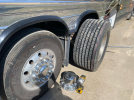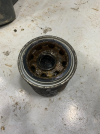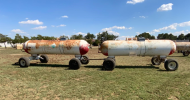We just got home from our 11-day, 4k mile (roughly) Spring Break trip heading to the California coast, Yosemite National Park, and bonus stop at Capulin Volcano in New Mexico on the way out.
Leading up to that, I ended up doing/completing a good sum of work. The power steering fluid and filter flush and differential fluid change were some of the items, but I also changed out the sway bar end link bushings with polyurethane (front and rear) and new shocks all around, plus drained the transmission fluid, refilled with fresh, and changed its filters.
And then about 48 hours before leaving, I finally found the source of the slow leak from one of my drive tires: a nail that was into the sidewall. Which moved up the timeline on another modification I wanted to do: converting the bus to super singles.

Conveniently, I had some super single wheels in stock, but not the tires. And inconveniently, the wheels I had in stock were the 0 offset as opposed to the 2" outset type, which is what I'd prefer (and what I had put onto the Endeavor). Hindsight being 20/20 I would've done that modification differently on it, but oh well. Fortunately, the local truck tire shop did have the super single size I needed in stock, and although it wasn't the type I was originally going for, I think I may have accidentally gotten a better tire than I was planning on buying.
All the modifications worked as expected. The shocks and sway bar bushings helped the ride and handling noticeably. One of the issues I'd noticed before was that the bus would list to one side noticeably when going through a turn, due to the slop in the very dead end link bushings (video coming soon on that one). The steering is better/easier than it was before and the power steering pump and box both sound happier now with fresh fluid. The transmission shifts better - it was a bit sluggish shifting between certain gears and would slip a bit. That's almost entirely gone away but it still persists in a few situations. I probably need to do another drain and refill just of the pan, since there's a lot of fluid in an automatic that doesn't get flushed when doing a drain and fill. But, noticeably improved.
The super singles I find to be a great improvement. They definitely help the ride in back, with no negative impacts on traction that I observed. Really they should have positive impacts in off-road due to the single wider patch vs. the dual narrower patches, and the tires I put on have a more aggressive tread pattern than the "all position" tires on previously. If anything, we think these are quieter, but that may have something to do with tire age as the old ones were a couple years older and I'm sure had a decent number of miles on them.
A bonus of the super single conversion was that we now have a spare tire. Granted it's a single 315, but that will do on the front or the tag as those were the original size. If I had a super single blow out and I needed to limp to a safe location I could switch some tires around to make that work, too. But really since we're normally towing the Jeep behind us, the easiest thing to do would be to pull the tire off, drive it to a place to get refitted, and then come back to put it back on since I carry the tools with me. Still, we like backup plans.
The bus performed very well and I do think that the economy improved slightly from what I'd seen on previous trips, although it wasn't a full apples to apples comparison since we were also towing the Jeep behind. But the engine ran well and seemed happy.
From my observations, there are some things I noted that should be improved.
- Like with the previous bus, the Allison 6-speed has too large of RPM drops in 3-4 and 4-5. 2-3 is more manageable. Part of the issue is that, with the transmission programming, it shifts at about 2000 RPM vs. the 2100 RPM rated power or 2150 RPM redline. If I hold it in a gear and let it get up to 2100-2150 before upshifting that does help get it to a bit higher in the next gear, which helps. But, this engine is allowed to spin to 2500 RPM when under engine braking (meaning the valve springs can handle higher RPM) and the marine versions are rated at 2300 RPM. If I got the redline (meaning fuel cutoff in this case) to go up to 2400, that would put those upshifts in a much better place on uphills, where it creates a problem.
- But also, as I'd observed previously, it looks from fuel flow as though the tune is topping out at 1300 ft-lb of torque rather than something in the 1450-1850 range like I think it should be based on what I've read. Really, I need to either get the DDEC tuning software myself or find someone else who has it to help with checking what tune is in there now and likely making some changes to what I want it to be. It's not uncommon for owners to put lower performance tunes in these if they don't trust the drivers. Still, it has plenty of power. Even coming through the steep mountains on I-80 east of Sacramento, no issues. We weren't maintaining 75 up the grade, but were easily going twice as fast as we were with the old bus last summer. Maybe more.
- The engine is amazingly smoke-free (although maybe this has to do with a weak tune). The only smoke I've seen from the exhaust so far has been at 7,000+ ft elevation, top gear, engine below 1500 RPM coasting, and then flooring it. A bit of smoke until the turbo spooled up then. That, to me, is acceptable.
Now, I need to think some more about what I want to get done before the next trip...



